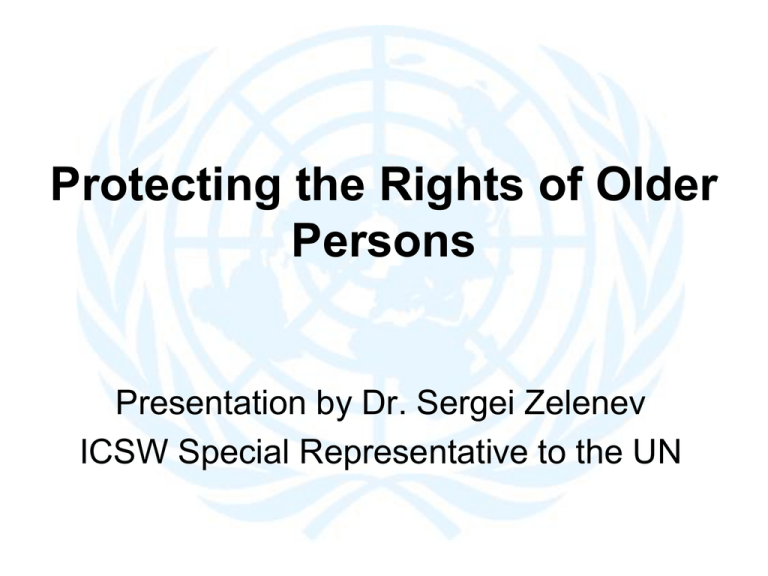Protecting the Rights of Older Persons
advertisement

Protecting the Rights of Older Persons Presentation by Dr. Sergei Zelenev ICSW Special Representative to the UN The evolving demographic situation and developmental significance of ageing • According to UN DESA Population Division between 1950 and 2010 life expectancy worldwide rose from 46 to 68 years; projected to increase to 81 by the end of the century. • Almost 700 million people are now over the age of 60, but by 2050 at least 2 billion people (over 20 percent of the world’s population) will be over 60 or older. Exceeding the number of children for the first time. • The largest increase in the developing world, the largest number in Asia, the fastest proportionate growth in Africa. • Sign of human progress but numerous challenges ahead The composition of the older population segment • The “oldest old” is also ageing at an accelerated rate and is projected to increase at least fourfold to reach 395 million in 2050. • Older women continue to outnumber older men as they represent 54% of all persons aged 60 years and above and 63% of those aged 80 and above. Human rights at the heart of all efforts This evolving situation inevitably raises questions • How will the growing number of older persons be cared for and adequate income support provided? • What kind of employment opportunities can society offer those who wish to remain economically active? • How can intergenerational solidarity be preserved and enhanced? • How to combat stigma, discrimination and violence against older persons? Visible differences In many higher income countries some degree of progress is being made in meeting obligations vis-avis older persons. The situation is completely different in developing countries. • Changes in family structures and increasing urbanization and migration have left many without traditional family support. • The situation of older persons in rural areas is particularly difficult. • The feminization of ageing also presents additional challenges. Gender Dimensions of Ageing • Women Constitute a majority of older population and are more likely than men to survive to older age • The majority of older men are married, but most older women are not • Older women are usually more likely to live alone Gender discrimination and violence against women The persistence of de jure discrimination, including the right to property and ownership rights; discrimination in marriage and family life The prevalence of violence against women through the life-cycle and into the old age The implications of negative stereotypes: prejudices against women are compounded in women’s old age, sometimes assuming vicious forms The Second World Assembly on Ageing in Madrid (2002) The Political Declaration and Madrid Plan reaffirmed commitment to the promotion and protection of human rights and called for the elimination of age discrimination, neglect, abuse and violence. Aim: Harnessing the potential of ageing in a much better way and address ageing from the perspective of both developing and developed countries Yet, ageing stays on the periphery of the internationally agreed development goals. That lack of attention is exemplified most obviously by the absence of any reference to ageing in the Millennium Declaration as well as the Millennium Development Goals. Some existing challenges Older persons represent a very diverse group and the issue of vulnerability associated with age should be approached very cautiously. Many older persons are very robust and do not require the support of society. But in any case older persons should not be marginalized and discriminated against. Their rights must be fully protected, promoted and buttressed with better implementation of existing laws as well as new norms and standards The international policy framework on ageing • The Vienna Plan of Action on Ageing (1982) • The Madrid Plan of Action on Ageing (2002) • The Principles for Older Persons (1991) Evolving approaches These three policy documents form an international framework on ageing and signify the evolution in thinking and policy. However, they do not provide legally binding obligations for State parties. Incorporating norms and precepts, which governments agreed to be guided by, these documents did not require from the member states an account for adherence. But, their significance should not be underestimated. They provide substantial specificity and offer a very useful guide for public policy action. Implementation hurdles Implementation of these “soft law” documents is largely predicated by the national capacity to implement them (including funding) as well as the political will to achieve positive outcomes. The Review and Appraisal of the Madrid Plan clearly revealed substantial flaws in the implementation of the Plan. Many commitments remain only on paper. Another set of documents containing obligations vis-à-vis older persons belong to specific international human rights instruments • The Universal Declaration on Human Rights • International Covenant on Civil and Political Rights • The International Covenant on Economic, Social and Cultural Rights • The Covenants are binding international instruments None of these instruments, however, explicitly refers to age as one of the prohibited grounds. Why? To a certain extent it could be explained that the major demographic trends and their implications became apparent much later compared to the time when these ground documents were conceived and conceptualized. In these documents the rights of older persons are alongside the essential rights of everyone else. Is it sufficient to address structural disadvantages of older people in society? There are several key provisions outlined in core treaties on human rights that have a particular relevance to the lives of older persons There are core tenets such as: • Non discrimination and equality • Equal rights of men and women • Rights relating to work • The right to social security • Protection of the family as the basic unit of society • The right to an adequate standard of living • The right to physical and mental health • The right to education and culture • The Convention on the Elimination of All Forms of Discrimination against Women makes references to old age with respect to the enjoyment of the right to social security Overall analysis of the documents and international legal instruments point to the existence of a certain “normative gap” • Age is not identified as a prohibited ground for discrimination resulting in discriminatory experiences of older persons worldwide. • Standards which offer older persons protection are dispersed through various human rights texts. • National human rights instruments remain invisible for both Government and the general public. • The obligations of private sector actors and individuals are not well developed. There are distinct differences between normative gaps and implementation gaps • The failure of states to abide by the commitments they have undertaken represents an implementation gap. • Normative gaps result from a failure of current provisions to provide specific guidance on how to give content and effect to existing norms. Failure of the current provisions vs. implementation failure Normative gaps also fail to address adequately existing practices which deny rights. One can speculate whether the implementation gap is a result of the normative gap, or provisions have not been successful at proving either the incentive or the safeguard to protect the rights of older persons. Lack of capacity Evidence of the lack of capacity of existing human rights instruments to effectively protect the rights of older persons can be revealed from an analysis of the reports that member states submit to human rights monitoring bodies. For example, from 2000-2008, the Human Rights Committee considered 124 State Reports in the contexts of scrutinizing Government committees under the International Covenant on Civil and Political Rights. The figures are very revealing: only three made specific reference to actions taken to address age discrimination and just one highlighted the vulnerability of older persons to abuse in long-term care homes. Age Blindness? It is somewhat unclear whether such figures provide convincing evidence of a lack of action on the part of Governments to address the rights of older persons. However, these figures reveal that many states remain “age blind” in their human rights reporting. Moreover, positive actions taken were not even outlined in the responses and states merely expressed concern for the situations that older people faced. Existing human rights infringements include discrimination against older persons • The roots of discrimination are connected to negative stereotypes related to older persons. • Discrimination reinforces a negative image of older persons as dependant people bound to have a decline in intellect, cognitive and physical performance. • Results in the perception of older persons as a burden on society rather than an asset, and contribute to vulnerability. Discrimination against older persons is well documented • In the workplace they can be denied promotional opportunities or even lose their jobs. • In healthcare they can be denied access to services or receive substandard or insufficient care. • In terms of education and culture, opportunities, including training and retraining schemes need to be made for people throughout their lives. Discrimination and abuse are widespread • In the area of pensions, older persons can be discriminated against, particularly older women who are often not entitled to receive old age pensions, despite the many years that they may have spent in providing care to the family. They may also not be eligible for their spouse’s pension if they become widows. • Older persons are more likely than younger adults to be illiterate, poor and uninformed about their own rights, increasing their vulnerability. • Elder abuse has become recognized as a universal phenomenon that cuts across culture and socioeconomic lines. Rights of Older Persons The mandate for the Open-ended Working Group on ageing was established in December 2010 by the GA to explore the existing gaps at the international level in the protection of human rights of older persons. Two meetings in 2011 so far explored: • How fundamental rights could be assured and deepened • Existing gaps • Feasibility of existing and further instruments to protect the human rights of older persons The recommendations focused on: • More effective data collection, statistics and qualitative information • Better assessment of the existing situation • Requirements for monitoring mechanisms Whither a Convention? A new convention cannot be elaborated without the political will of member states acting in close cooperation with civil society organizations and other stakeholders. However, some countries agreed that convention could address many important issues. • Institutional ageism • Provide a clear definition of the specific obligations of member states with regard to the rights of older persons • Strengthen and complement existing international policy documents on ageing and provide redress for the violation of human rights • Encourage a more equitable allocation of resources for older persons • Create new rights and principles • Provide older persons with more visibility and recognition Advantages of the new instruments The elaboration of a convention could facilitate a dialogue and positive interaction between government, civil society and private sector, helping to overcome gaps regarding existing discrimination, violence and abuse, threats to income and property, enhancing social protection, access to health care, including long-term care and home care. The role of a Special Rapporteur was also contemplated to receive reports from member states and advise them on the implementation of MIPAA. The Rapporteur could promote rights by naming problem areas and identifying strategies for their resolution. These options are not mutually exclusive. Participation in policymaking, political and cultural life Participation in all spheres provides guarantees against social exclusion and isolation. The political participation of older persons is itself a right as well as a way to play active role in society with dignity. In order to buttress the rights of older persons and move the agenda on ageing forward, the efforts of all stakeholders must be combined so that “a society for all ages” moves from a slogan to reality. Thank you








